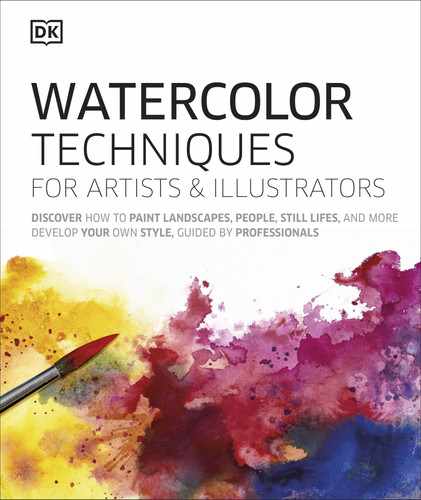
Y
e
l
l
o
w
-
g
r
e
e
n
R
e
d
-
o
r
a
n
g
e
B
l
u
e
-
g
r
e
e
n
Y
e
l
l
o
w
-
o
r
a
n
g
e
B
l
u
e
-
p
u
r
p
l
e
P
u
r
p
l
e
R
e
d
-
p
u
r
p
l
e
O
r
a
n
g
e
THE BASICS
The painter’s color wheel
The traditional painter’s color wheel is based on one
designed by Isaac Newton and its purpose is to show a
logical relationship between the different colors of the
painter’s spectrum. The color wheel is a representation
Color theory
UNDERSTANDING COLOR RELATIONSHIPS AND TONE
When it comes to painting, the three primary colors are red, yellow, and blue.
In theory, all other colors could be mixed from the three primaries, but in
practice additional colors are often used to extend the possible range.
Primary colors
Red, yellow, and blue are primary colors.
You cannot create primary colors using any
other colors.
Secondary colors
If you mix two primary colors (such as red
and yellow) you create a secondary color
(orange). These sit between primary colors.
Tertiary colors
If you mix a secondary color (such as purple)
with an adjacent primary color (say, blue),
you create the tertiary color blue-purple.
of how any color interacts with others. Only 12 colors
are shown, when in reality, of course, there will be
almost innite subtle variations. The more colors that
are added the duller a mixture gets.
Complementary colors
Colors that sit opposite one another on the color wheel—red and
green, say—are known as complementary. They brighten each
other when placed alongside but dull each other on mixing.
Analogous colors
Colors that sit next to one another in groups of
three to ve are said to be analogous. They
create harmonious color schemes.
Red Green
Yellow Purple
OrangeBlue
R
E
D
R
E
D
Y
E
L
L
O
W
Y
E
L
L
O
W
B
L
U
E
B
L
U
E
G
r
e
e
n
G
r
e
e
n
P
u
r
p
l
e
O
r
a
n
g
e
A
n
a
l
o
g
o
u
s
32
US_032-033_Colour_theory.indd 32 02/04/2020 3:33pm

B
l
u
e
-
g
r
e
e
n
R
e
d
-
p
u
r
p
l
e
Color theory
The tone of a color
Tone (also known as value) refers to the
measure of the lightness or darkness of
a color. A good range of tone makes for a
realistic representation of light and 3-D
form. The range of tones you can mix
using watercolor is much less than what
you see in nature. Effectively the darkest
tone of any color is a pure dark (black)
and the lightest tone is pure light (white).
Adjusting the tonal value
Adjusting the lightness or darkness of
a color, either by altering the saturation
or adding a darker hue, alters its tone or
tonal value. The exercise above uses only
a small range of values, yet the forms are
perfectly described through just four
variations of one color.
33
A range of tones
All of these objects are white, but under
this controlled lighting a full range of tone
is evident. Your eyes see their 3-D forms
as varying tones; in this monochrome
scene, these go from white to dark gray.
Tonal map to recreate the scene
For this tonal exercise, rst draw the
connected tonal shapes—lights, mediums,
and darks—while ignoring the boundaries of
objects. Paint all areas with a light wash (1);
next paint areas 2 with a medium wash,
then apply a dark wash to areas 3.
Finally, add black for the darkest darks (4).
Darkening a color
We can extend the range of tones
available by adding a dark to the pure
color. When the color is darkened, its
tonal value is lowered.
Lightening a color
In watercolor, rather than adding white
to lighten a color (as with other paints),
water is used to produce a graduation
of strength of color (saturation).
Tone 1—light Tone 2—medium Tone 3—dark Tone 4—black
Graduating tone indicates
the form of this sphere
See how edges disappear
when the tone is the
same, either side
Shadows make up
the darkest tones
The bright white of the
bottle meets the darker
background at an edge
A medium wash will
be applied to areas 2
Only a light wash
covers areas 1
2
2
2
4
4
1
1
1
1
3
3
3
3
3
3
2
2
2
2
2
US_032-033_Colour_theory.indd 33 02/04/2020 3:33pm
..................Content has been hidden....................
You can't read the all page of ebook, please click here login for view all page.
